tokonoma
tokonoma is an abstract strategy board game for two players. It is vaguely similar to chess, checkers or Hive.
Players battle it out on a cramped board with strangely hopping pieces that can stack, a tangle of eclectic
attack patterns, and an unusual mechanic for capturing. Despite its unassuming size, tokonoma offers remarkable
depth.
You can play in local multiplayer or against the computer at various difficulty levels.
Rules
Setup
A board of 29 hexagonal tiles is setup as follows.
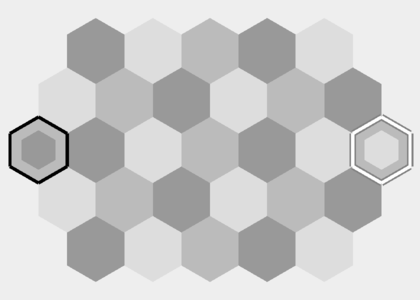
White, who moves first, starts on the right side and moves to the left. For white, forward is left.
Black starts on the left and moves to the right. For black, forward is right.
The rightmost tile is White's house, the leftmost tile is Black's house.
The pieces are laid out like this:
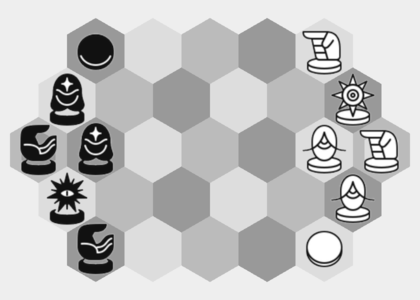
Pieces
All pieces move and attack according to some specific pattern. A piece can only move into an empty tile, with the sole exception of stacking (see below). When a piece moves by more than one tile, it always jumps over any obstacle -- only whether the final tile is occupied matters.
Flats
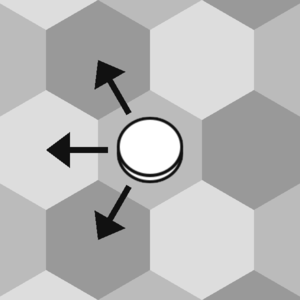 |
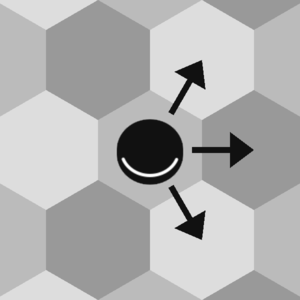 |
Flats move one tile forward, or one tile forward-sideways.
When a flat reaches the opponent's house, the player immediately wins.
Arm
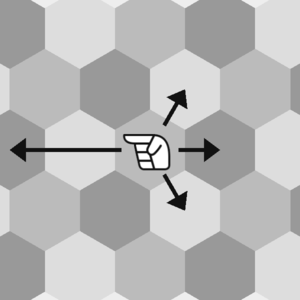 |
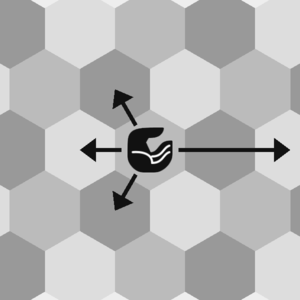 |
The Arm or Hand can move either two tiles forward, one tile backwards, or one tile backward-sideways.
Blind
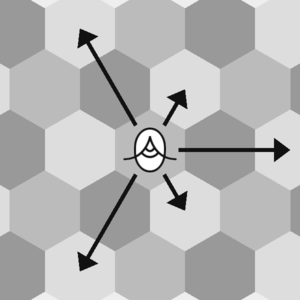 |
 |
The Blind can move either two tiles forward-sideways, two tiles backwards, or one tile backward-sideways.
All the tiles the Blind can move to on a given turn are the same color. In fact, the White Blind always cycles mid -> light -> dark -> mid, and the Black Blind always cycles mid -> dark -> light -> mid.
Star
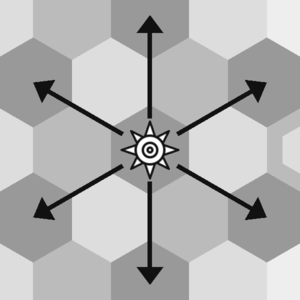 |
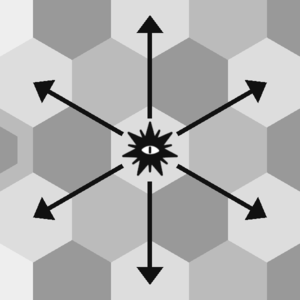 |
The Star can move one step diagonally, along the edges of the tiles. More simply, the Star is bound to its original tile color, and can move to the six closest tiles of the same color.
Thus, the White Star is bound to dark tiles, and the Black Star is bound to light tiles.
Talls and Stacking

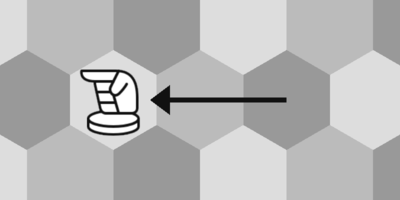
A tall-piece (Arm, Blind, or Star) may move onto a Flat of the same color, so that they stack and occupy the same tile. (A flat cannot move into a tall to stack under it.)
When stacked, the flat is essentially inactive, as it can neither move nor attack. The tall, instead, attacks and is free to move off the flat.
Stacks are just as vulnerable to attacks as the lone pieces.
Turns
A player's turn consists of two stages:
Movement
The player must move one of their pieces by a legal move according to the patterns above. If there are no legal moves available, the player has lost (stalemate).
Attack
All of the player's pieces (including those that were not just moved) automatically attack all
of the opponent's pieces. A tile is under attack if a player's piece could move into it, or in other words,
pieces attack in the same pattern as they move. For example: a flat can only attack in front, not
backwards, because that's how it moves.
Any opponent's piece which is under attack from at least two pieces is captured and removed from play. Stacked pieces are equally vulnerable, and will be captured together.
An attacking piece may contribute to attacking multiple targets at the same time.
(Note: the opponent does not counter-attack during this stage. Only the player that just moved attacks.)
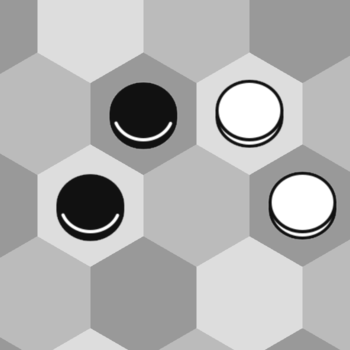 |
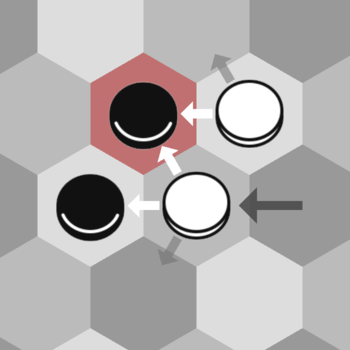 |
In this example, White pushes forward a flat; since White just moved, only their pieces attack. The upper Black flat is under attack by two pieces, and thus is captured. The lower Black flat is not captured since it is only under attack by one piece.
Even though white's flat walked into a double attacked tile itself, it is not captured since it was not Black's turn.
Thus the game phases alternate like this:
- White moves
- White attacks Black
- Black moves
- Black attacks White
- White moves
- ...
Win Conditions
The game can finish in either of two ways:
- House Capture: If a player's flat (not a tall) reaches the opponent's house tile, that player wins.
- Stalemate: If a player starts their turn with no legal moves, they lose.
Draw by repetition
While unlikely, it is possible to have a non-terminating game. A rule to determine a draw could be applied; one idea is to limit the number of consecutive reversible moves (i.e. every X moves there should be a flat push or a capture). This implementation does not apply any such rule, and bots do not correctly account for it.
Details
tokonoma is free and open source. I made it exclusively for fun. I won't ask you for a dime and you can find the (extremely messy) source code here.
This applies also to the specification of the board game itself, which means you are free to do what you want with it for non-commercial purposes, including writing your own implementations, writing bots, creating variants of the game, or making physical sets. As long as you don't sell it, nothing is sacred.
| Status | Released |
| Platforms | HTML5, Windows |
| Rating | Rated 3.6 out of 5 stars (8 total ratings) |
| Author | bad_vertex |
| Genre | Strategy, Puzzle |
| Made with | Inkscape, Audacity, Rust |
| Tags | 2D, Abstract, Board Game, Chess, Local multiplayer, mind-bending, Minimalist, No AI |
| Code license | GNU General Public License v3.0 (GPL) |
| Average session | A few minutes |
| Languages | English |
| Inputs | Mouse |
| Accessibility | Color-blind friendly, High-contrast, One button |
| Multiplayer | Local multiplayer |
| Player count | 1 - 2 |
| Links | GitHub |
Download
Development log
- In-game rules cheatsheetJan 15, 2025
- Starting Position EditorJan 13, 2025





Comments
Log in with itch.io to leave a comment.
It would be nice to see the move patterns of the selected piece in game (not just the legal moves), so you don't have to scroll down to the description constantly.